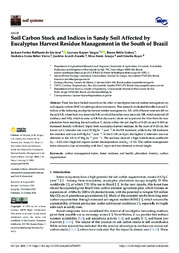Soil carbon stock and indices in sandy soil affected by Eucalyptus Harvest residue management in the South of Brazil.
Soil carbon stock and indices in sandy soil affected by Eucalyptus Harvest residue management in the South of Brazil.
Author(s): SÃO JOSÉ, J. F. B. de; VARGAS, L. K.; LISBOA, B. B.; VIEIRA, F. C. B.; ZANATTA, J. A.; ARAUJO, E. F.; BAYER, C.
Summary: Abstract: There has been limited research on the effect of eucalyptus harvest residue management on soil organic carbon (SOC) in subtropical environments. This research evaluated the effect on soil C indices of the following eucalyptus harvest residue managements: AR, with all forest remnants left on the soil; NB, where bark was removed; NBr, in which branches were removed; NR, which removed all residues; and NRs, which is same as NR but also used a shade net to prevent the litter from the new plantation from reaching the soil surface. C stocks within the soil depths of 0?20 cm and 0?100 cm increased linearly with the C input from eucalyptus harvest residues. In the layer of 0?20 cm, the lowest soil C retention rate was 0.23 Mg ha−1 year−1, in the NR treatment, while in the AR treatment, the retention rate was 0.68 Mg ha−1 year−1. In the 0?100 cm layer, the highest C retention rate was obtained in the AR (1.47 Mg ha−1 year−1). The residues showed a high humification coefficient (k1 = 0.23) and a high soil organic matter decomposition rate (k2 = 0.10). The carbon management index showed a close relationship with the C input and tree diameter at breast height.
Publication year: 2023
Types of publication: Journal article
Unit: Embrapa Forestry
Observation
Some of Embrapa's publications are published as ePub files. To read them, use or download one of the following free software options to your computer or mobile device. Android: Google Play Books; IOS: iBooks; Windows and Linux: Calibre.
Access other publications
Access the Agricultural Research Database (BDPA) to consult Embrapa's full library collection and records.
Visit Embrapa Bookstore to purchase books and other publications sold by Embrapa.

